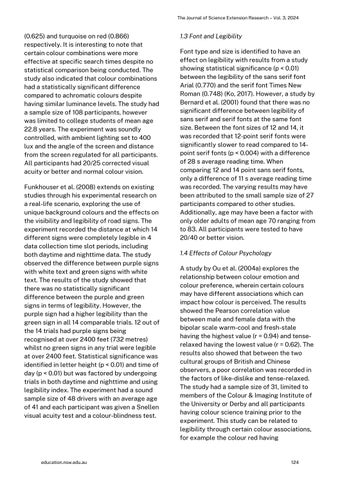The Journal of Science Extension Research – Vol. 3, 2024
(0.625) and turquoise on red (0.866) respectively. It is interesting to note that certain colour combinations were more effective at specific search times despite no statistical comparison being conducted. The study also indicated that colour combinations had a statistically significant difference compared to achromatic colours despite having similar luminance levels. The study had a sample size of 108 participants, however was limited to college students of mean age 22.8 years. The experiment was soundly controlled, with ambient lighting set to 400 lux and the angle of the screen and distance from the screen regulated for all participants. All participants had 20/25 corrected visual acuity or better and normal colour vision. Funkhouser et al. (2008) extends on existing studies through his experimental research on a real-life scenario, exploring the use of unique background colours and the effects on the visibility and legibility of road signs. The experiment recorded the distance at which 14 different signs were completely legible in 4 data collection time slot periods, including both daytime and nighttime data. The study observed the difference between purple signs with white text and green signs with white text. The results of the study showed that there was no statistically significant difference between the purple and green signs in terms of legibility. However, the purple sign had a higher legibility than the green sign in all 14 comparable trials. 12 out of the 14 trials had purple signs being recognised at over 2400 feet (732 metres) whilst no green signs in any trial were legible at over 2400 feet. Statistical significance was identified in letter height (p < 0.01) and time of day (p < 0.01) but was factored by undergoing trials in both daytime and nighttime and using legibility index. The experiment had a sound sample size of 48 drivers with an average age of 41 and each participant was given a Snellen visual acuity test and a colour-blindness test.
education.nsw.edu.au
1.3 Font and Legibility Font type and size is identified to have an effect on legibility with results from a study showing statistical significance (p < 0.01) between the legibility of the sans serif font Arial (0.770) and the serif font Times New Roman (0.748) (Ko, 2017). However, a study by Bernard et al. (2001) found that there was no significant difference between legibility of sans serif and serif fonts at the same font size. Between the font sizes of 12 and 14, it was recorded that 12-point serif fonts were significantly slower to read compared to 14point serif fonts (p < 0.004) with a difference of 28 s average reading time. When comparing 12 and 14 point sans serif fonts, only a difference of 11 s average reading time was recorded. The varying results may have been attributed to the small sample size of 27 participants compared to other studies. Additionally, age may have been a factor with only older adults of mean age 70 ranging from to 83. All participants were tested to have 20/40 or better vision. 1.4 Effects of Colour Psychology A study by Ou et al. (2004a) explores the relationship between colour emotion and colour preference, wherein certain colours may have different associations which can impact how colour is perceived. The results showed the Pearson correlation value between male and female data with the bipolar scale warm-cool and fresh-stale having the highest value (r = 0.94) and tenserelaxed having the lowest value (r = 0.62). The results also showed that between the two cultural groups of British and Chinese observers, a poor correlation was recorded in the factors of like-dislike and tense-relaxed. The study had a sample size of 31, limited to members of the Colour & Imaging Institute of the University or Derby and all participants having colour science training prior to the experiment. This study can be related to legibility through certain colour associations, for example the colour red having
124













